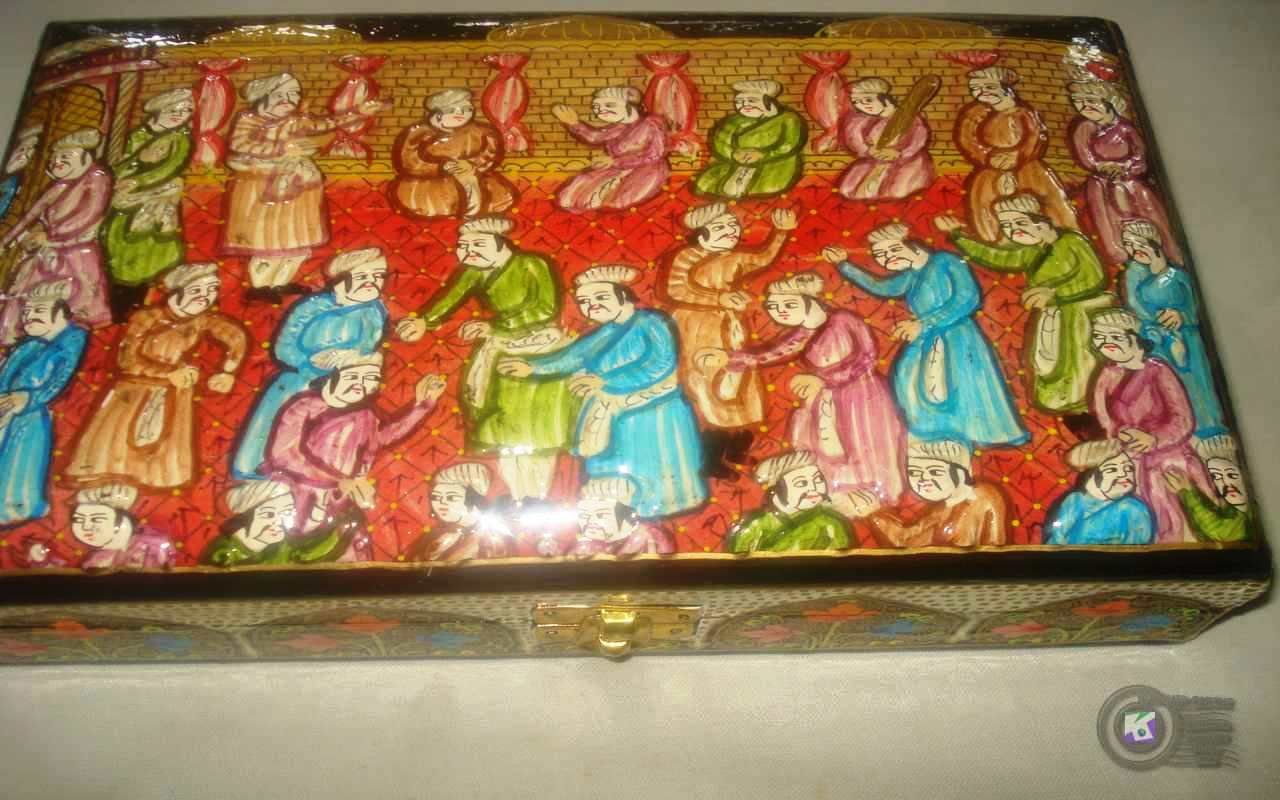Papier-mâché
Papier-mâché is a composite material consisting of paper pieces or pulp, sometimes reinforced with textiles, bound with an adhesive, such as glue, starch, or wallpaper paste.
Kashmiri papier-mâché is a handicraft of Kashmir that was brought by Muslim saint Mir Sayyid Ali Hamadani from Persia in the 14th century to medieval India. Kashmiri paper mache items are individually created, and each one tells its own special story.
This art form is primarily based on paper pulp, and produces richly decorated, colourful artefacts, generally in the form of vases, bowls or cups, bases of lamps, and many other small objects. These are generally made in homes or workshops, in Srinagar and other parts of Kashmir.
In Kashmir, Papier Mache originated in the form of making pen cases from paper pulp (base). The qalamdans (pen cases) were in turn covered with floral or geometric patterns and finished with a coat of rogan (Varnish). For this reason the craft was initially referred to as Kariqalamdan (the art of making pen cases). The art involves two processes: Sakhtasaazi (making of base product) and Naqashi (painting) which gives a decorative touch with intricate designs.
The Rich Heritage of Kashmiri Papier-Mâché
Introduction Papier-mâché, a composite material made from paper pieces or pulp bound with adhesive, has a unique and rich history, particularly in Kashmir. This art form, known as Kashmiri papier-mâché, was introduced to medieval India by the Muslim saint Mir Sayyid Ali Hamadani from Persia in the 14th century. Each Kashmiri papier-mâché item is handcrafted, telling its own special story through intricate designs and vibrant colors.
Historical Roots Originally, this craft was known as Kariqalamdan or the art of making pen cases (qalamdans) from paper pulp. These pen cases were adorned with floral or geometric patterns and finished with rogan (varnish), showcasing the skill of the artisans. Over time, the craft evolved to include a variety of objects, from vases and bowls to lamp bases and other decorative items.
Artistic Processes The creation of Kashmiri papier-mâché involves two main processes:
- Sakhtasaazi (Base Making): This step involves molding paper pulp into the desired shape, creating a sturdy base for the artwork.
- Naqashi (Painting): This process adds the decorative touch, featuring intricate designs painted by skilled artisans. The designs often include traditional motifs such as flowers, birds, and geometric patterns.
Cultural Significance Kashmiri papier-mâché is not only a testament to the region’s artistic heritage but also a vital part of its cultural identity. The craft is typically practiced in homes and workshops in Srinagar and other parts of Kashmir, preserving the traditional techniques passed down through generations.
Amazing Facts
- Handcrafted Masterpieces: Each papier-mâché item is handcrafted, ensuring that no two pieces are exactly alike.
- Eco-Friendly: The use of recycled paper makes papier-mâché an environmentally friendly craft.
- Intricate Designs: The Naqashi process can take weeks or even months to complete, depending on the complexity of the design.
Kashmiri papier-mâché is a beautiful blend of artistry and tradition, reflecting the rich cultural heritage of Kashmir. Whether it’s a decorative bowl, a colorful vase, or an intricately designed lamp base, each piece of papier-mâché art is a testament to the skill and creativity of Kashmiri artisans. Embrace this timeless art form and bring a piece of Kashmir’s history and beauty into your home.














